Short Essay: Deforestation and Forest Degradation in Australia
VerifiedAdded on 2022/09/05
|5
|990
|15
Essay
AI Summary
This essay examines the significant issue of deforestation and forest degradation in Australia, focusing on the factors that have contributed to this environmental problem. It delves into the historical context, highlighting the role of European colonization and subsequent human activities like urbanization and logging in diminishing the country's forest cover. The essay explores the adverse impacts of deforestation, including climate change, erosion, loss of biodiversity, and the destruction of animal habitats. It also discusses the effects of bushfires and the fragmentation of the remaining forest cover. The essay concludes by emphasizing the need for close monitoring and management of deforestation and forest degradation to protect Australia's natural environment and biodiversity. The essay uses references to support the arguments.
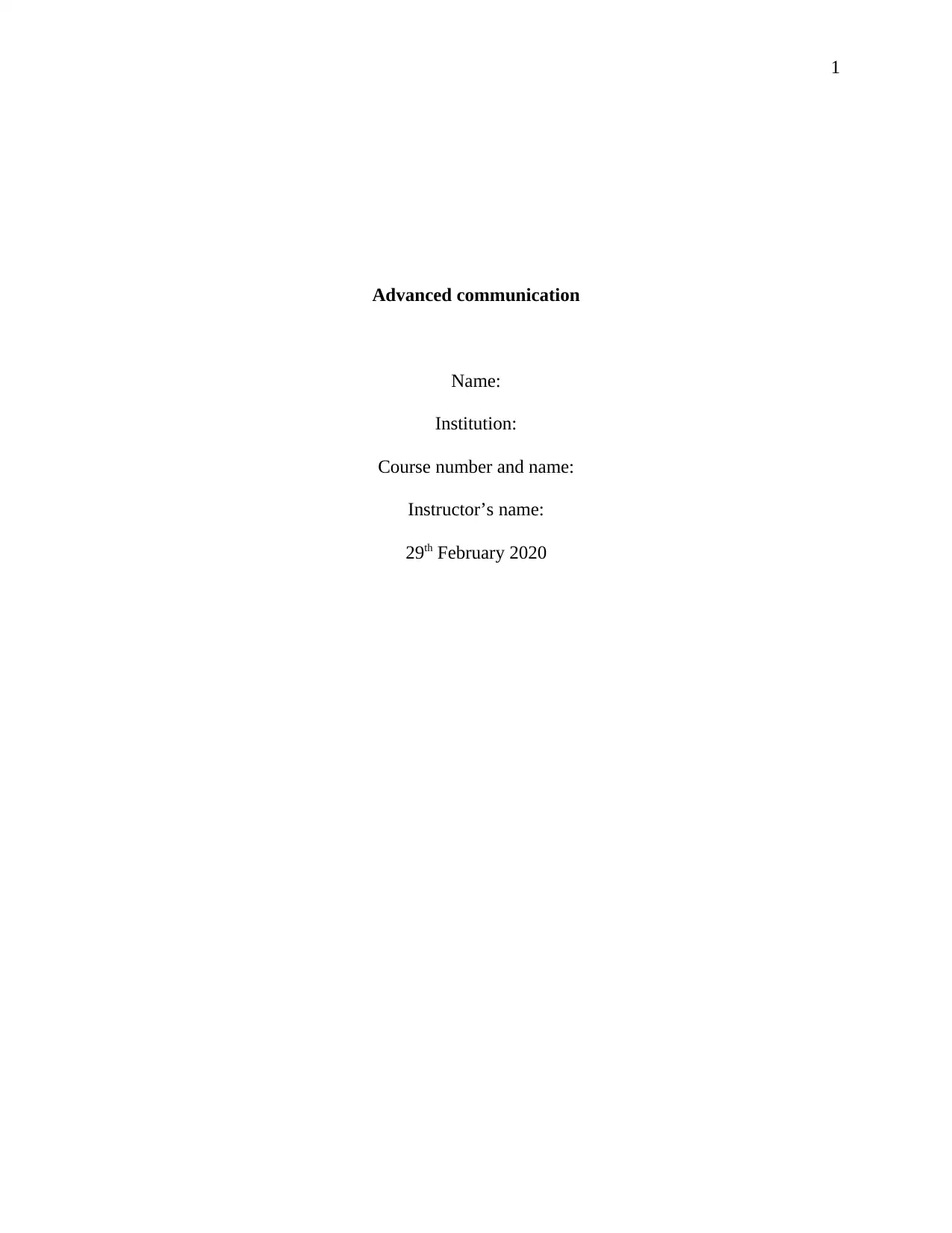
1
Advanced communication
Name:
Institution:
Course number and name:
Instructor’s name:
29th February 2020
Advanced communication
Name:
Institution:
Course number and name:
Instructor’s name:
29th February 2020
Paraphrase This Document
Need a fresh take? Get an instant paraphrase of this document with our AI Paraphraser
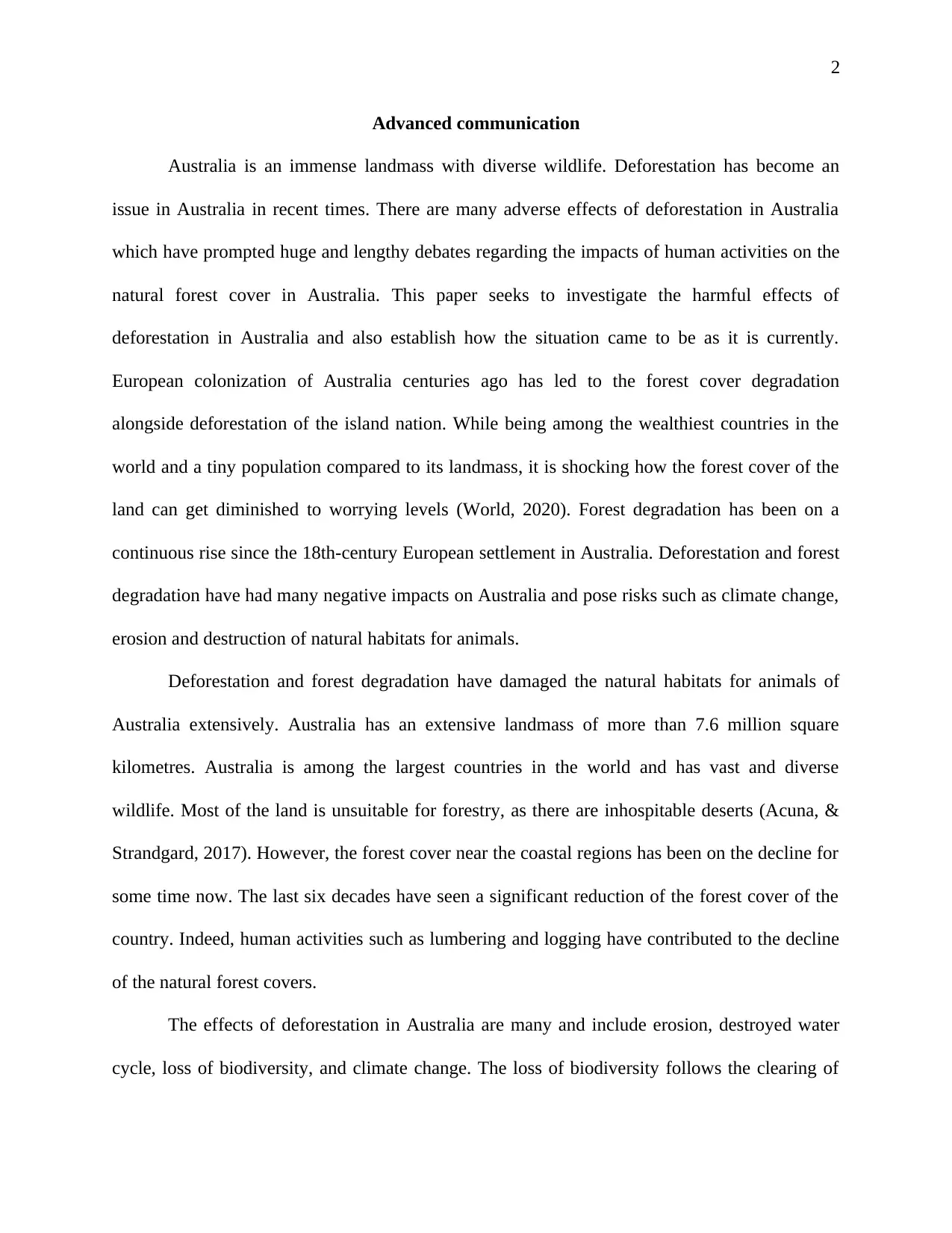
2
Advanced communication
Australia is an immense landmass with diverse wildlife. Deforestation has become an
issue in Australia in recent times. There are many adverse effects of deforestation in Australia
which have prompted huge and lengthy debates regarding the impacts of human activities on the
natural forest cover in Australia. This paper seeks to investigate the harmful effects of
deforestation in Australia and also establish how the situation came to be as it is currently.
European colonization of Australia centuries ago has led to the forest cover degradation
alongside deforestation of the island nation. While being among the wealthiest countries in the
world and a tiny population compared to its landmass, it is shocking how the forest cover of the
land can get diminished to worrying levels (World, 2020). Forest degradation has been on a
continuous rise since the 18th-century European settlement in Australia. Deforestation and forest
degradation have had many negative impacts on Australia and pose risks such as climate change,
erosion and destruction of natural habitats for animals.
Deforestation and forest degradation have damaged the natural habitats for animals of
Australia extensively. Australia has an extensive landmass of more than 7.6 million square
kilometres. Australia is among the largest countries in the world and has vast and diverse
wildlife. Most of the land is unsuitable for forestry, as there are inhospitable deserts (Acuna, &
Strandgard, 2017). However, the forest cover near the coastal regions has been on the decline for
some time now. The last six decades have seen a significant reduction of the forest cover of the
country. Indeed, human activities such as lumbering and logging have contributed to the decline
of the natural forest covers.
The effects of deforestation in Australia are many and include erosion, destroyed water
cycle, loss of biodiversity, and climate change. The loss of biodiversity follows the clearing of
Advanced communication
Australia is an immense landmass with diverse wildlife. Deforestation has become an
issue in Australia in recent times. There are many adverse effects of deforestation in Australia
which have prompted huge and lengthy debates regarding the impacts of human activities on the
natural forest cover in Australia. This paper seeks to investigate the harmful effects of
deforestation in Australia and also establish how the situation came to be as it is currently.
European colonization of Australia centuries ago has led to the forest cover degradation
alongside deforestation of the island nation. While being among the wealthiest countries in the
world and a tiny population compared to its landmass, it is shocking how the forest cover of the
land can get diminished to worrying levels (World, 2020). Forest degradation has been on a
continuous rise since the 18th-century European settlement in Australia. Deforestation and forest
degradation have had many negative impacts on Australia and pose risks such as climate change,
erosion and destruction of natural habitats for animals.
Deforestation and forest degradation have damaged the natural habitats for animals of
Australia extensively. Australia has an extensive landmass of more than 7.6 million square
kilometres. Australia is among the largest countries in the world and has vast and diverse
wildlife. Most of the land is unsuitable for forestry, as there are inhospitable deserts (Acuna, &
Strandgard, 2017). However, the forest cover near the coastal regions has been on the decline for
some time now. The last six decades have seen a significant reduction of the forest cover of the
country. Indeed, human activities such as lumbering and logging have contributed to the decline
of the natural forest covers.
The effects of deforestation in Australia are many and include erosion, destroyed water
cycle, loss of biodiversity, and climate change. The loss of biodiversity follows the clearing of
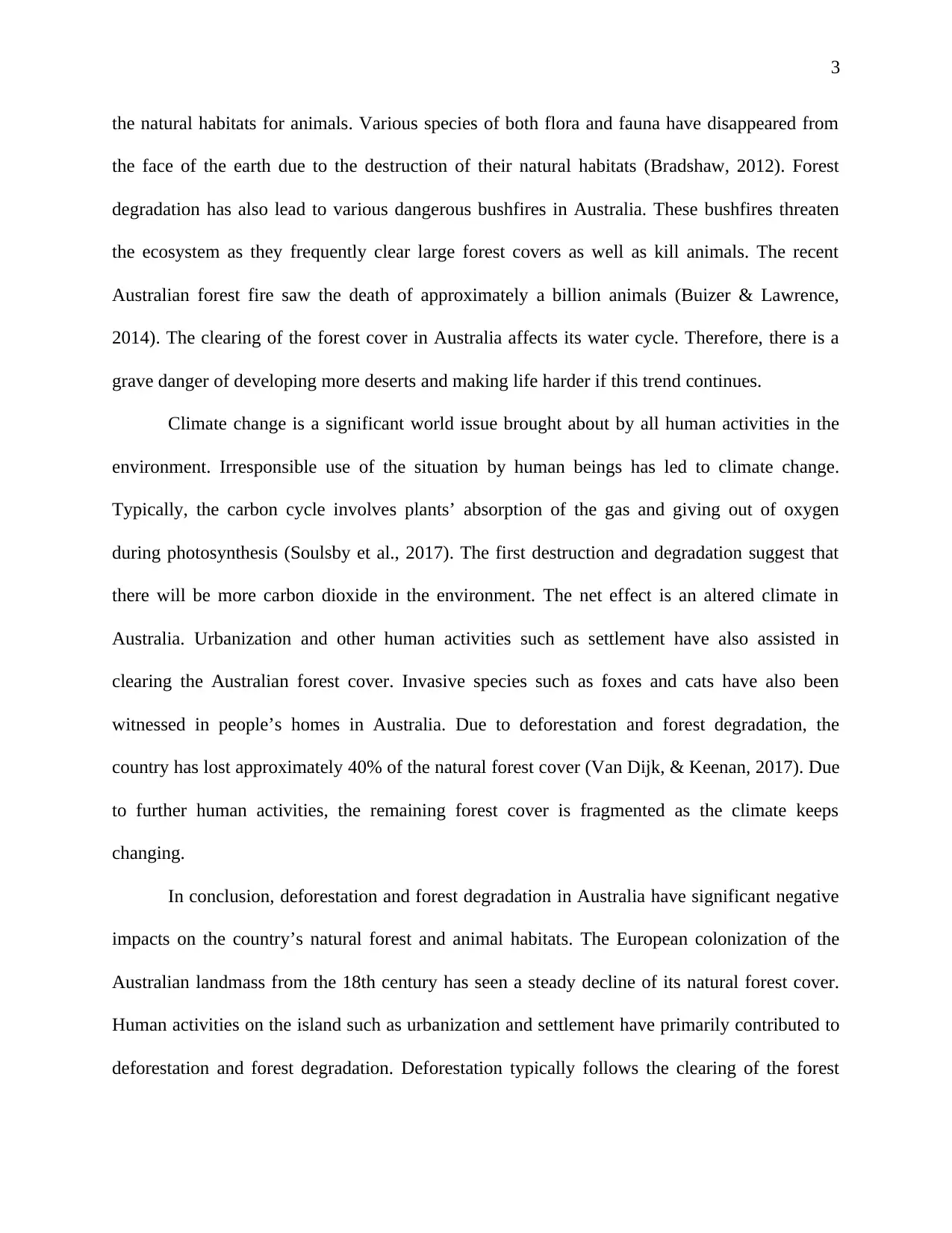
3
the natural habitats for animals. Various species of both flora and fauna have disappeared from
the face of the earth due to the destruction of their natural habitats (Bradshaw, 2012). Forest
degradation has also lead to various dangerous bushfires in Australia. These bushfires threaten
the ecosystem as they frequently clear large forest covers as well as kill animals. The recent
Australian forest fire saw the death of approximately a billion animals (Buizer & Lawrence,
2014). The clearing of the forest cover in Australia affects its water cycle. Therefore, there is a
grave danger of developing more deserts and making life harder if this trend continues.
Climate change is a significant world issue brought about by all human activities in the
environment. Irresponsible use of the situation by human beings has led to climate change.
Typically, the carbon cycle involves plants’ absorption of the gas and giving out of oxygen
during photosynthesis (Soulsby et al., 2017). The first destruction and degradation suggest that
there will be more carbon dioxide in the environment. The net effect is an altered climate in
Australia. Urbanization and other human activities such as settlement have also assisted in
clearing the Australian forest cover. Invasive species such as foxes and cats have also been
witnessed in people’s homes in Australia. Due to deforestation and forest degradation, the
country has lost approximately 40% of the natural forest cover (Van Dijk, & Keenan, 2017). Due
to further human activities, the remaining forest cover is fragmented as the climate keeps
changing.
In conclusion, deforestation and forest degradation in Australia have significant negative
impacts on the country’s natural forest and animal habitats. The European colonization of the
Australian landmass from the 18th century has seen a steady decline of its natural forest cover.
Human activities on the island such as urbanization and settlement have primarily contributed to
deforestation and forest degradation. Deforestation typically follows the clearing of the forest
the natural habitats for animals. Various species of both flora and fauna have disappeared from
the face of the earth due to the destruction of their natural habitats (Bradshaw, 2012). Forest
degradation has also lead to various dangerous bushfires in Australia. These bushfires threaten
the ecosystem as they frequently clear large forest covers as well as kill animals. The recent
Australian forest fire saw the death of approximately a billion animals (Buizer & Lawrence,
2014). The clearing of the forest cover in Australia affects its water cycle. Therefore, there is a
grave danger of developing more deserts and making life harder if this trend continues.
Climate change is a significant world issue brought about by all human activities in the
environment. Irresponsible use of the situation by human beings has led to climate change.
Typically, the carbon cycle involves plants’ absorption of the gas and giving out of oxygen
during photosynthesis (Soulsby et al., 2017). The first destruction and degradation suggest that
there will be more carbon dioxide in the environment. The net effect is an altered climate in
Australia. Urbanization and other human activities such as settlement have also assisted in
clearing the Australian forest cover. Invasive species such as foxes and cats have also been
witnessed in people’s homes in Australia. Due to deforestation and forest degradation, the
country has lost approximately 40% of the natural forest cover (Van Dijk, & Keenan, 2017). Due
to further human activities, the remaining forest cover is fragmented as the climate keeps
changing.
In conclusion, deforestation and forest degradation in Australia have significant negative
impacts on the country’s natural forest and animal habitats. The European colonization of the
Australian landmass from the 18th century has seen a steady decline of its natural forest cover.
Human activities on the island such as urbanization and settlement have primarily contributed to
deforestation and forest degradation. Deforestation typically follows the clearing of the forest
⊘ This is a preview!⊘
Do you want full access?
Subscribe today to unlock all pages.

Trusted by 1+ million students worldwide
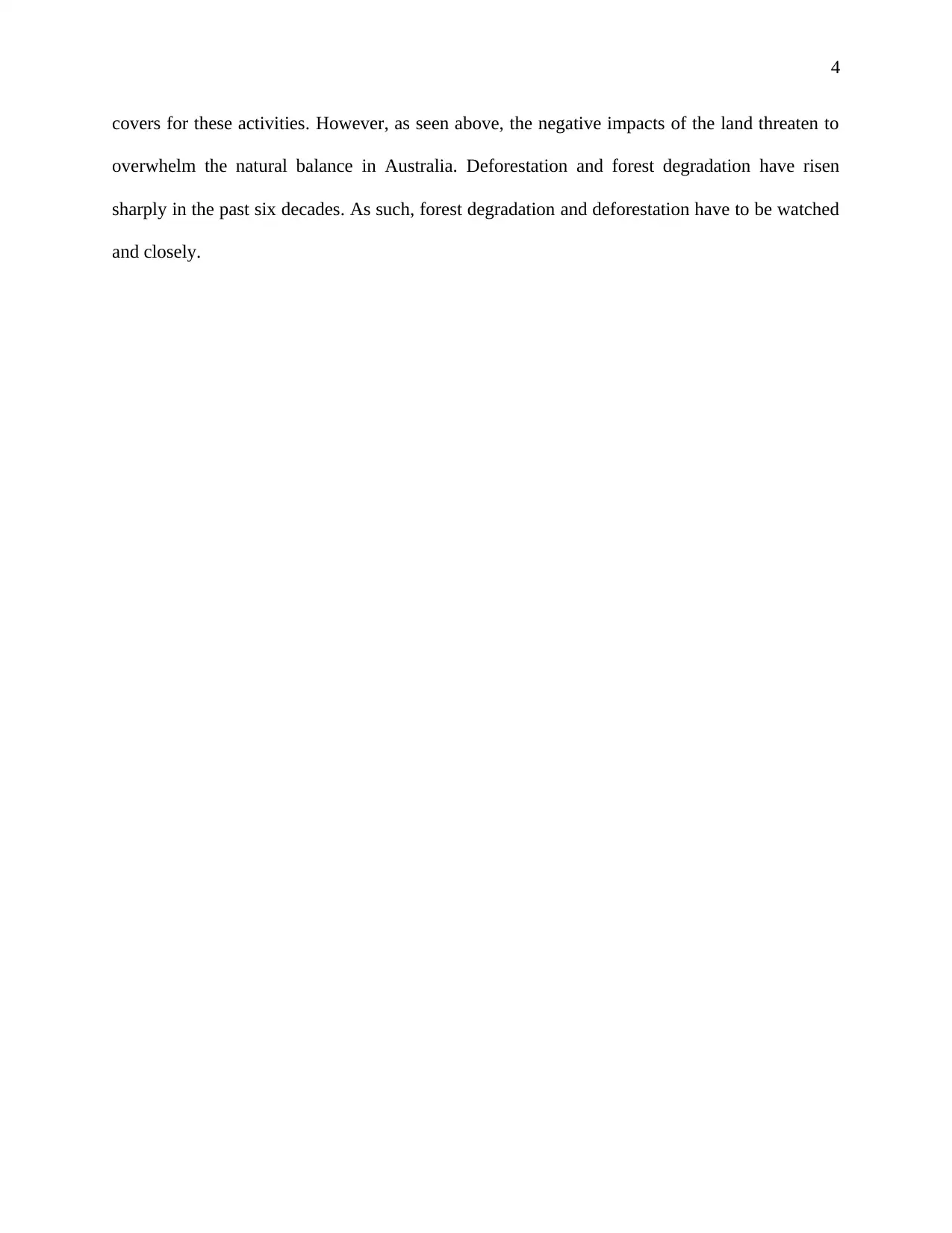
4
covers for these activities. However, as seen above, the negative impacts of the land threaten to
overwhelm the natural balance in Australia. Deforestation and forest degradation have risen
sharply in the past six decades. As such, forest degradation and deforestation have to be watched
and closely.
covers for these activities. However, as seen above, the negative impacts of the land threaten to
overwhelm the natural balance in Australia. Deforestation and forest degradation have risen
sharply in the past six decades. As such, forest degradation and deforestation have to be watched
and closely.
Paraphrase This Document
Need a fresh take? Get an instant paraphrase of this document with our AI Paraphraser
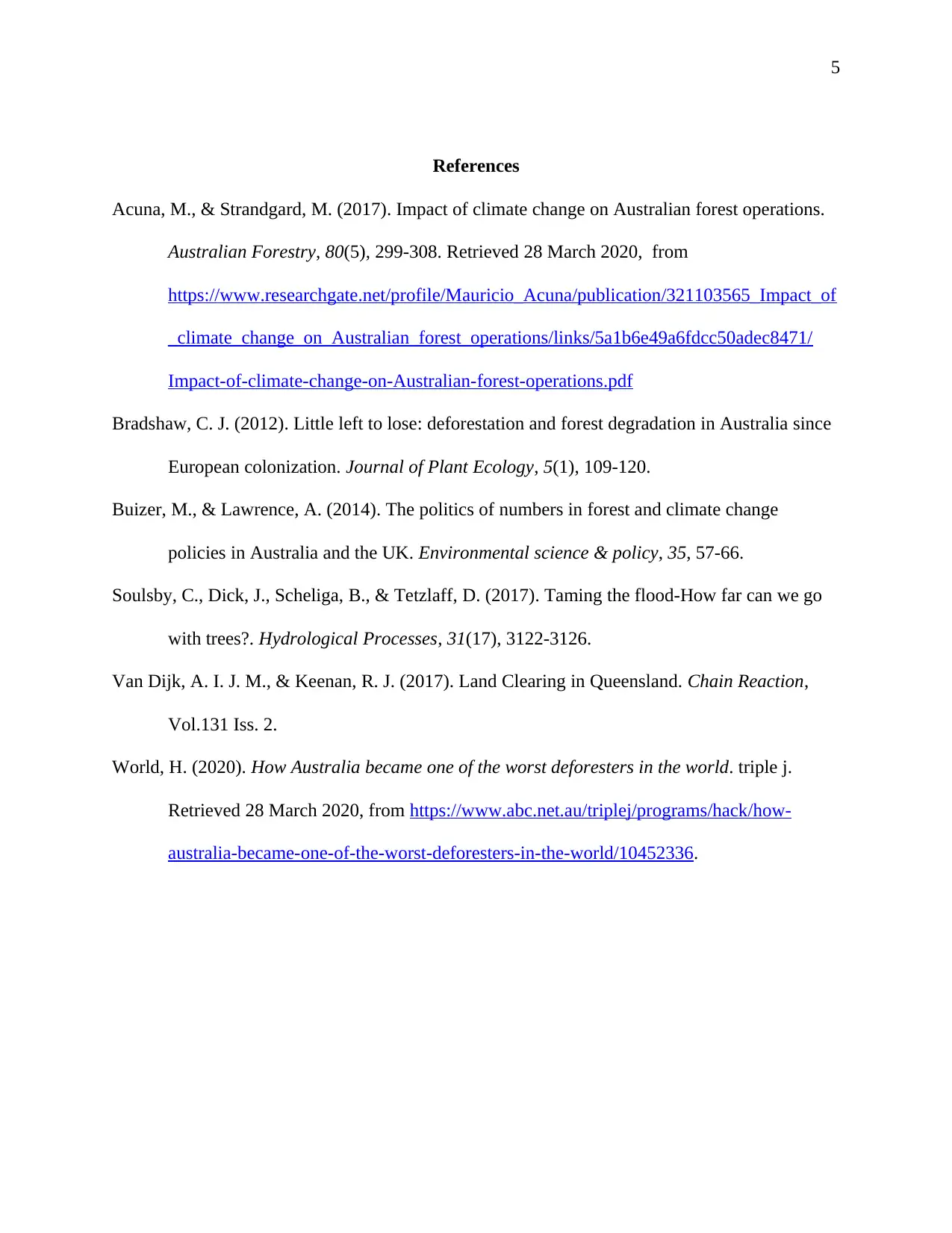
5
References
Acuna, M., & Strandgard, M. (2017). Impact of climate change on Australian forest operations.
Australian Forestry, 80(5), 299-308. Retrieved 28 March 2020, from
https://www.researchgate.net/profile/Mauricio_Acuna/publication/321103565_Impact_of
_climate_change_on_Australian_forest_operations/links/5a1b6e49a6fdcc50adec8471/
Impact-of-climate-change-on-Australian-forest-operations.pdf
Bradshaw, C. J. (2012). Little left to lose: deforestation and forest degradation in Australia since
European colonization. Journal of Plant Ecology, 5(1), 109-120.
Buizer, M., & Lawrence, A. (2014). The politics of numbers in forest and climate change
policies in Australia and the UK. Environmental science & policy, 35, 57-66.
Soulsby, C., Dick, J., Scheliga, B., & Tetzlaff, D. (2017). Taming the flood-How far can we go
with trees?. Hydrological Processes, 31(17), 3122-3126.
Van Dijk, A. I. J. M., & Keenan, R. J. (2017). Land Clearing in Queensland. Chain Reaction,
Vol.131 Iss. 2.
World, H. (2020). How Australia became one of the worst deforesters in the world. triple j.
Retrieved 28 March 2020, from https://www.abc.net.au/triplej/programs/hack/how-
australia-became-one-of-the-worst-deforesters-in-the-world/10452336.
References
Acuna, M., & Strandgard, M. (2017). Impact of climate change on Australian forest operations.
Australian Forestry, 80(5), 299-308. Retrieved 28 March 2020, from
https://www.researchgate.net/profile/Mauricio_Acuna/publication/321103565_Impact_of
_climate_change_on_Australian_forest_operations/links/5a1b6e49a6fdcc50adec8471/
Impact-of-climate-change-on-Australian-forest-operations.pdf
Bradshaw, C. J. (2012). Little left to lose: deforestation and forest degradation in Australia since
European colonization. Journal of Plant Ecology, 5(1), 109-120.
Buizer, M., & Lawrence, A. (2014). The politics of numbers in forest and climate change
policies in Australia and the UK. Environmental science & policy, 35, 57-66.
Soulsby, C., Dick, J., Scheliga, B., & Tetzlaff, D. (2017). Taming the flood-How far can we go
with trees?. Hydrological Processes, 31(17), 3122-3126.
Van Dijk, A. I. J. M., & Keenan, R. J. (2017). Land Clearing in Queensland. Chain Reaction,
Vol.131 Iss. 2.
World, H. (2020). How Australia became one of the worst deforesters in the world. triple j.
Retrieved 28 March 2020, from https://www.abc.net.au/triplej/programs/hack/how-
australia-became-one-of-the-worst-deforesters-in-the-world/10452336.
1 out of 5
Related Documents
Your All-in-One AI-Powered Toolkit for Academic Success.
+13062052269
info@desklib.com
Available 24*7 on WhatsApp / Email
![[object Object]](/_next/static/media/star-bottom.7253800d.svg)
Unlock your academic potential
Copyright © 2020–2025 A2Z Services. All Rights Reserved. Developed and managed by ZUCOL.





